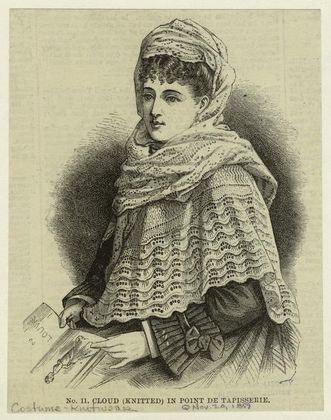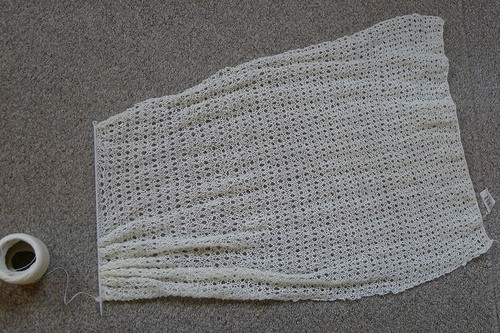 When making your own cloud there are three things to consider: pattern, yarn, and needle size. Patterns for making clouds and nubias can be found as early as 1859 and as late as 1916. (Unfortunately, the pattern for the illustration on the right does not seem to be available online.) They are great projects for beginner knitters because the patterns are often very simple. Ragged Soldier Sutlery has collected two patterns for nubias from historical sources published in 1859. These two patterns are easy to use, and one even has a modern interpretation. The Lady's Knitting-Book (1874) by Elvina Corbould gives a more complicated pattern for a Canadian Cloud, which involves a white Shetland scarf that is two and a half yards long and bordered with "scarlet crochet" and has both ends gathered up and finished with "a large tassel" (60). The Bazaar, Exchange and Mart, And Journal of the Household (Volume XXI September 17, 1879) also gives directions for knitting a Canadian cloud that seems to be more square in shape, since it involves casting on "244 stitches" and knitting "264 rows" (180). This version of the cloud also has the ends gathered and trimmed with tassels. While it recommends using "[p\lain white, salmon pink, and pale blue" Pyrenean, Shetland, or Andalusian wool for a solid-coloured scarf, it also suggests "darker colours and stripes in two contrasting colours, three of each" for "poor persons" (180). More information on clouds can be found on the West Coast Fibre Arts website, where the host Wendy has collected some patterns and made a cloud of her own. The yarn should be a very light one, preferably a lace weight or super fine weight (fingering or baby weight). The recommended yarns from period patterns are also all wools, so consider using a 100% wool fibre yarn. The fluffiness of the yarn will help create the cloud-like nature of the scarf. While many of the types of yarn are no longer available, Shetland, which is often recommended for clouds, is still manufactured by people in Scotland. It can be a bit pricey, so if you don't feel like splurging on yarn really any soft, lightweight, fluffy wool will do. Remember, you're going to be wrapping it around your head, face, and neck, so pick something that feels comfortable against your skin. Needles should be fairly large, especially compared to the weight of the yarn. I would recommend anything from 4mm to 6mm needles (that's 6-10 in US needle sizes). Try out a couple of rows in your chosen pattern to see if you like how it looks. It should be light and lacy and cloud-like. The stitches will look quite big and loose. See below for a picture of my own in-progress cloud, which uses lace-weight Shetland wool and size 4.5mm needles in a lacy knit pattern that I made up. Respectfully yours, Sabrina
1 Comment
11/22/2019 05:51:17 pm
A new home also means a new start. I have had a rough couple of months, and I want nothing more than to start over. I know that this is not something that I should be sharing, but I just cannot hold it anymore. I have had some suicidal thoughts in the past, it was all because of my previous environment. When I felt like I could not stand it anymore, I decide to move out. Today, is the first day of my new life.
Reply
Leave a Reply. |
AuthorGenevieve Woods Archives
May 2019
Categories |

 RSS Feed
RSS Feed